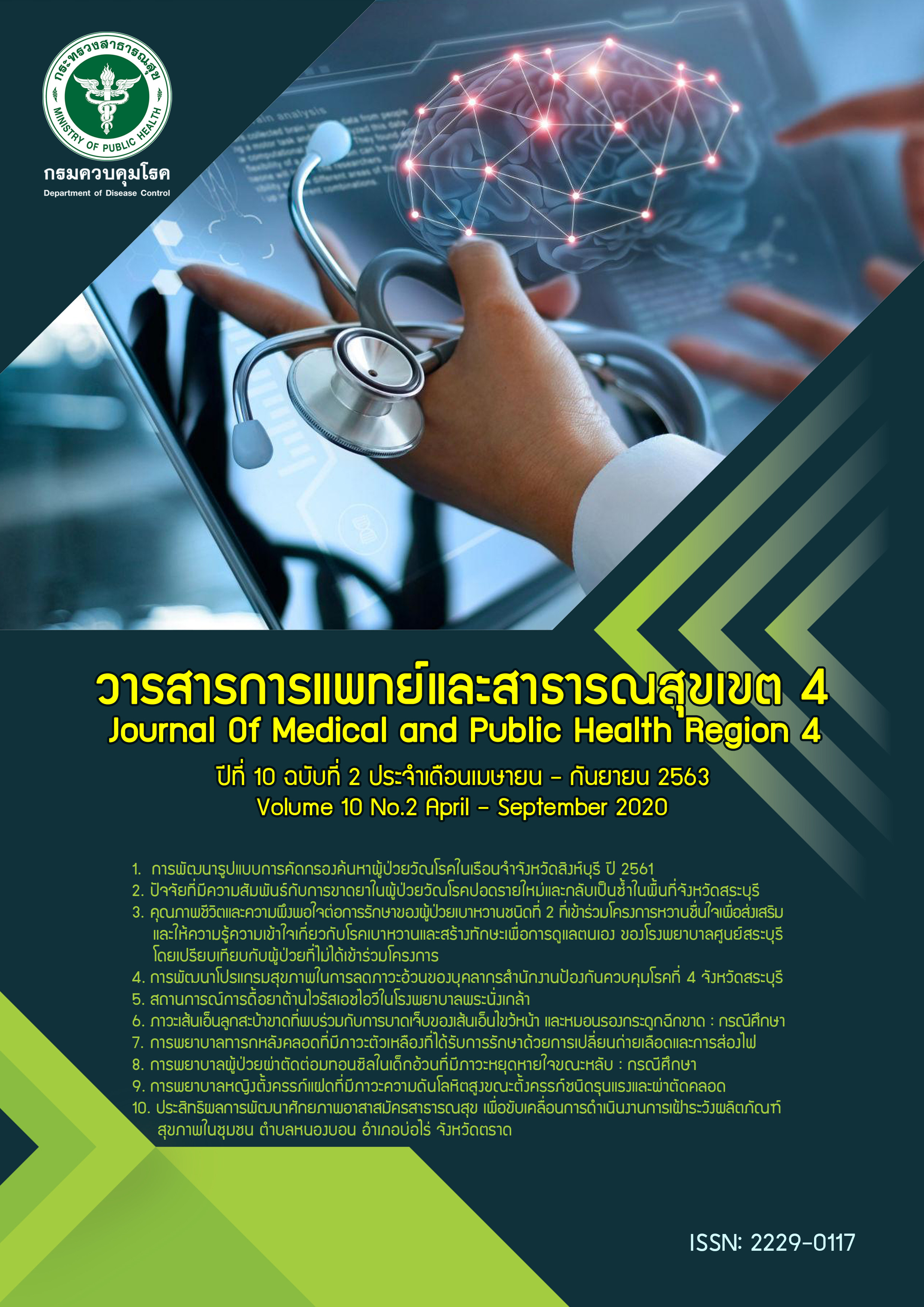Factors Associated with Lost to Follow-up in New and Relapsed Pulmonary Tuberculosis Patients in Saraburi Province
Main Article Content
Abstract
The objective of this research was to study the factors associated with loss to follow-up among new and relapsed pulmonary tuberculosis (TB) patients in Saraburi Province. The subjects were 344 new and relapsed TB patients registered during October 2016 – September 2019 in hospitals under Ministry of Public Health in Saraburi Province. The new and relapsed TB case record form was developed for the study. Descriptive statistics in the study included frequency, percentage, mean, median, standard deviation and rank. A chi-square test was performed to compare between TB cases with follow-up and loss to follow-up (significant level at 0.05). Odds ratios (OR) with 95% confidence intervals (95% CI) were presented. A multiple logistic regression analysis was then performed to determine factors associated with loss to follow-up TB cases after adjusting for other co-variables. Adjusted odds ratios () with 95% confidence intervals were presented in the results of analysis. Of 344 new and relapsed pulmonary TB cases, 76.7% were male, 21.5% were aged 45-54 year-old, 62.5% were unemployed, 66.3% had universal health insurance, 92.4% hadn’t co-morbid, 66.0% being TB contact, 29.7% had smear sputum 3+, 58.4% hadn’t lung cavity, 95.9% received standard drugs, and 63.4 were patients with no DOT. The multiple logistic regression analysis showed factors associated with loss to follow-up cases were aged ≤ 65 years old (
5.059; 95% CI 1.199, 21.344),having body weight <35 kgs (
106.795; 95% CI 32.572, 350.153), and having no cavity on chest X-ray (
4.483; 95% CI 1.874, 10.725). Results from this study suggest that disease prevention and control workers should focus on Improve directly observation therapy (DOT) which will help reduce the loss to follow-up rate among new and relapsed pulmonary TB patients. Patients aged ≤ 65 years old, having body weight <35 kgs, and having no cavity in chest X-ray who have increased loss to follow-up should received much attention for TB case management.
Article Details
References
2.กรมควบคุมโรค สำนักวัณโรค. แนวทางการควบคุมวัณโรคประเทศไทย พ.ศ. 2561. กรุงเทพมหานคร: อักษรกราฟฟิคแอนด์ดีไซน์; 2561.
3.National Tuberculosis Information Program [อินเตอร์เน็ต]. กรุงเทพมหานคร: สำนักวัณโรค; 2018. [เข้าถึงเมื่อ 1 ตุลาคม 2561].เข้าถึงได้จาก : https://tbcmthailand.net
4.จิระวรรณ พึ่งสกุล. อัตราการขาดยาและปัจจัยที่เกี่ยวข้องต่อการขาดยาของผู้ป่วยวัณโรคปอดรายใหม่ในระบบประกันสังคมของโรงพยาบาลเอกชน จังหวัดสมุทรปราการ. [วิทยานิพนธ์]. กรุงเทพ: จุฬาลงกรณ์มหาวิทยาลัย; 2548.
5.Garrido MdS, Penna ML, Perez-Porcuna TM, Souza ABd, MarreiroLdS, Albuquerque BC, et al. Factors Associated with Tuberculosis Treatment Default in an Endemic Area of the Brazilian Amazon: A Case Control-Study. PLoS One 2012; 7(6): e39134. https://doi.org/10.1371/journal.pone.0039134
6.อรทัย ศรีทองธรรม, อมรรัตน์ จงตระการสมบัติ, อุบลศรี ทาบุดดา, ศิริวรรณ อุทธา, ชุติมา ผลานันท์. ปัจจัยที่มีความสัมพันธ์กับการขาดยาและรักษาล้มเหลวในผู้ป่วยวัณโรคดื้อยาในพื้นที่สำนักงานป้องกันควบคุมโรคที่ 7 จังหวัดอุบลราชธานี. วารสารวิชาการสาธารณสุข. 2560; 26: S289-S298.
7.วราภรณ์ แสงวิเชียร, จิราพร คําแก้ว, ชญานิน กําลัง, ปริญดา จันทร์บรรเจิด, มยุรี พงศ์เพชรดิถ. ปัจจัยที่มีผลต่ออัตราความสําเร็จในการรักษาวัณโรคปอด ในคลินิกวัณโรค โรงพยาบาลนพรัตนราชธานี. วารสารเภสัชศาสตร์อีสาน 2558; 11(3): 83-91.
8.นรเทพ อัศวพัชระ. ปัจจัยที่มีผลต่อความสำเร็จของการรักษาผู้ป่วยวัณโรคปอดในจังหวัดระนอง. วารสารสมาคมเวชศาสตร์ป้องกันแห่งประเทศไทย 2561; 8(2): 200-211.
9. World Health Organization. Adherence to long-term therapies: evidence for action.Geneva: WHO; 2003.
10. Yamane Taro. Statistics: An Introductory Analysis. Third edition. New York: Harper and Row Publication; 1973.
11. วิลาวรรณ สมทรง. ปัจจัยที่มีความสัมพันธ์กับผลการรักษาวัณโรคในผู้ป่วยที่อายุ 60 ปีขึ้นไป. วารสารควบคุมโรค 2562; 45(2): 191-200.
12.สำนักวัณโรค กรมควบคุมโรค. คู่มือการให้การปรึกษาในงานวัณโรคและวัณโรคดื้อยา สำหรับบุคลากรสาธารณสุข.กรุงเทพมหานคร: อักษรกราฟฟิคแอนด์ดีไซน์ ; 2560.
13. ไพฑูรย์ อุ่นบ้าน. การพัฒนาระบบการดูแลรักษาวัณโรคด้วยระบบยาระยะสั้นแบบมีพี่เลี้ยง (DOTS) ของโรงพยาบาลแม่วาง จังหวัดเชียงใหม่. วารสารสาธารณสุขล้านนา 2559; 12(1): 23-36.
14. สุรเดชช ชวะเดช. การพัฒนารูปแบบของการรักษาวัณโรคแบบมีพี่เลี้ยงกำกับ (DOT) อำเภอห้วยทับทัน จังหวัดศรีสะเกษ. วารสารสมาคมเวชศาสตร์ป้องกันแห่งประเทศไทย 2561; 8(3): 339-351.


